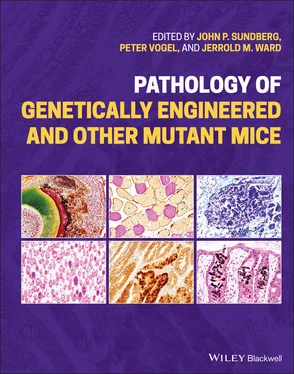Pathology of Genetically Engineered and Other Mutant Mice
Здесь есть возможность читать онлайн «Pathology of Genetically Engineered and Other Mutant Mice» — ознакомительный отрывок электронной книги совершенно бесплатно, а после прочтения отрывка купить полную версию. В некоторых случаях можно слушать аудио, скачать через торрент в формате fb2 и присутствует краткое содержание. Жанр: unrecognised, на английском языке. Описание произведения, (предисловие) а так же отзывы посетителей доступны на портале библиотеки ЛибКат.
- Название:Pathology of Genetically Engineered and Other Mutant Mice
- Автор:
- Жанр:
- Год:неизвестен
- ISBN:нет данных
- Рейтинг книги:3 / 5. Голосов: 1
-
Избранное:Добавить в избранное
- Отзывы:
-
Ваша оценка:
- 60
- 1
- 2
- 3
- 4
- 5
Pathology of Genetically Engineered and Other Mutant Mice: краткое содержание, описание и аннотация
Предлагаем к чтению аннотацию, описание, краткое содержание или предисловие (зависит от того, что написал сам автор книги «Pathology of Genetically Engineered and Other Mutant Mice»). Если вы не нашли необходимую информацию о книге — напишите в комментариях, мы постараемся отыскать её.
An updated and comprehensive reference to pathology in every organ system in genetically modified mice Pathology of Genetically Engineered and Other Mutant Mice
Pathology of Genetically Engineered and Other Mutant Mice
Pathology of Genetically Engineered and Other Mutant Mice — читать онлайн ознакомительный отрывок
Ниже представлен текст книги, разбитый по страницам. Система сохранения места последней прочитанной страницы, позволяет с удобством читать онлайн бесплатно книгу «Pathology of Genetically Engineered and Other Mutant Mice», без необходимости каждый раз заново искать на чём Вы остановились. Поставьте закладку, и сможете в любой момент перейти на страницу, на которой закончили чтение.
Интервал:
Закладка:
The thymus plays a critical role in T cell development. Every day, approximately 100 precursor T cells enter the thymus from the bone marrow. Differentiation, positive and negative selection, and maturation of T cells occur as the precursors migrate from the outer cortex to the medulla. Approximately 1 million mature T cells leave the thymus daily via blood vessels at the corticomedullary junction.
Examination of the thymus: For routine examination, H&E slides prepared from cross sections of the thymus fixed in formalin will suffice. For more detailed investigation of the stromal and epithelial cell composition, immunohistochemistry with antibodies against specific cell populations is necessary. To examine the effect of changes on T lymphocyte development, flow cytometry with multiple fluorochrome‐conjugated antibodies is required.
Aging‐associated changes: The thymus reaches its maximum size of 25–45 mg at about 5–6 weeks of age. When mice reach sexual maturity, the thymus undergoes involution with a gradual loss of lymphocytes. The loss of parenchymal tissue is partially compensated by an increase of stromal cells. There are marked differences between mouse strains in the weight of the thymus and degree of involution [12].
Cysts: Cysts are typically found in the medulla and at the corticomedullary junction of the thymus. They are lined by ciliated or squamous cells and may contain proteinaceous fluid, lymphocytes, and dendritic cells ( Figure 7.2). The prevalence of these cysts is age and strain‐dependent.
Thymic hypoplasia and aplasia: The thymus and parathyroid glands are both derived from the endoderm of the third pharyngeal pouch. Neural crest‐derived mesenchyme contributes to the migration and early formation of the thymus, but the thymus in young adult mice contains few if any neural crest‐derived cells. Functional deletion of genes involved in the formation and patterning of the pharyngeal arches cause thymic aplasia or hypoplasia and frequently affect other tissues that are derived from these embryonal structures ( Table 7.1). The most common defect in thymus development in humans is DiGeorge syndrome, caused by a deletion in chromosome 22q11.2, and characterized by cardiac and facial abnormalities and hypothyroidism. This chromosomal segment contains the Tbx1 gene and deletion of this gene in mice recapitulates the features of DiGeorge syndrome. A more selective defect in thymus development is induced by deletion of Foxn1, which is the genetic defect in the nude mouse. As mentioned earlier, FOXN1 is critical for the differentiation and maturation of both cortical and medullary epithelial cells, and spontaneous or engineered deletion induces thymic aplasia with sometimes only a cystic remnant present in the cranial mediastinum ( Figure 7.2). FOXN1 also plays a role in the formation of the hair shaft as this transcription factor regulates various keratin gene. Nude mice have hair follicles, but lack visible hair because of abnormal and fragile hair shafts (see Chapter 10on skin, hair, and nail for details).Mice with defects in the production of T lymphocytes have small thymuses comprised predominantly of epithelial and stromal cells with few lymphocytes. This includes mice with impaired formation of T cell receptors including mutations in the Prkdc gene that underlies the scid mutation [22], and in the Rag1 or Rag2 genes [23, 24], and mice with mutations in the Il2rg gene that encodes for the IL2 receptor common gamma chain (CD132) [25, 26].
Thymic hyperplasia: Focal hyperplasia of thymic epithelial cells has been reported in older B6C3F1 mice [27]. Focal lymphoid hyperplasia and development of follicles sometimes with germinal centers in the thymus medulla have been reported in NZB and NZBWF1 mice that are prone to systemic autoimmune disease similar to systemic lupus erythematosus [11, 28].
Secondary Lymphoid Organs
Lymph Nodes
Among invertebrate and vertebrate animals, lymph nodes are found only in mammals. Afferent lymph vessels collect lymph fluid from organs and tissues, which allows LNs to monitor peripheral tissues for infections and tissue damage and to act as a barrier to further dissemination of potential pathogens. Specialized mesenchymal stromal cells and endothelial cells secrete chemotactic factors that control the migration of lymphocytes that enter LNs via high endothelial venules and afferent lymph vessels. In this manner, LNs play an essential role in maximizing the chances for antigen to find the rare B and T lymphocytes that express the receptors for that specific antigen. The number of lymph nodes in mice raised in a clean environment is fairly constant with about 22 LNs found in specific locations [29].
Lymph node anlagen are formed as a result of interactions between lymphoid tissue organizer (LTo) cells and lymphoid tissue inducer (LTi) cells during ED14 to ED17 [30, 31]. Secretion of CXCL13 by LTo cells recruits LTi cells released from the fetal liver. Accumulation and activation of LTi cells results in further recruitment of LTi cells in a lymphotoxin and RANK‐dependent manner followed by the recruitment of B and T lymphocytes and differentiation of stromal cells in subtypes that populate the different compartments of the lymph node. LTi cells are a type of innate lymphoid cells, whereas the LTo cells include mesenchymal stromal cells and lymphatic endothelial cells. The relative role of stromal LTo cells and lymphatic endothelial cells in the initiation of LN formation is controversial [30, 31]. Understanding the process of LN formation is clinically relevant because the same signals are thought to be involved in the generation of tertiary lymphoid tissues which can be found in cancer and chronic inflammatory lesions [32, 33].
Table 7.1 Defects in thymus development in genetically engineered mice.
| Targeted mutation (gene) | Thymus | Other defects | References |
|---|---|---|---|
| Eya1 | Aplasia | Absence of ears, kidneys, parathyroid aplasia, thyroid hypoplasia | [13, 14] |
| Foxn1 | Aplasia | Hair shaft defects | [15] |
| Hoxa3 | Aplasia | Parathyroid aplasia, thyroid hypoplasia | [16] |
| Pax1 | Hypoplasia | Skeletal defects | [17] |
| Pax3 | Aplasia | Cardiac defects, parathyroid aplasia, thyroid aplasia, neural tube defects | [18] |
| Pax9 | Aplasia | Parathyroid aplasia, skeletal defects, absence of teeth | [19] |
| Six1 | Aplasia | Absence of kidneys, parathyroid aplasia, skeletal defects | [20] |
| Tbx1 | Aplasia | Parathyroid aplasia, cardiac defects, skeletal defects, cleft palate | [21] |
Lymph nodes can be divided into the cortex, paracortex, and medulla. B cell follicles are located in the cortex and contain follicular dendritic cells, specialized stromal cells that retain immune complexes on their surface and play an important role in the affinity maturation and longevity of the humoral immune response. The paracortex is populated by T cells and dendritic cells, and contains the high endothelial venules that permit the extravasation of naïve B and T lymphocytes. The medulla is composed of medullary cords which contain macrophages and plasma cells, and medullary sinuses that converge into a single efferent lymphatic vessel. Antigens reach the lymph node via afferent lymphatics that open into the subcapsular sinus. The “floor” of the subcapsular sinus is lined by endothelial cells that limit diffusion of antigens into the underlying lymphoid tissue. At least five different types of macrophages can be identified in lymph nodes based on their localization and phenotype [34]. These are the subcapsular sinus macrophages, tingible body macrophages in germinal centers, T cell zone macrophages in the paracortex, and medullary cord and medullary sinus macrophages.
Читать дальшеИнтервал:
Закладка:
Похожие книги на «Pathology of Genetically Engineered and Other Mutant Mice»
Представляем Вашему вниманию похожие книги на «Pathology of Genetically Engineered and Other Mutant Mice» списком для выбора. Мы отобрали схожую по названию и смыслу литературу в надежде предоставить читателям больше вариантов отыскать новые, интересные, ещё непрочитанные произведения.
Обсуждение, отзывы о книге «Pathology of Genetically Engineered and Other Mutant Mice» и просто собственные мнения читателей. Оставьте ваши комментарии, напишите, что Вы думаете о произведении, его смысле или главных героях. Укажите что конкретно понравилось, а что нет, и почему Вы так считаете.












